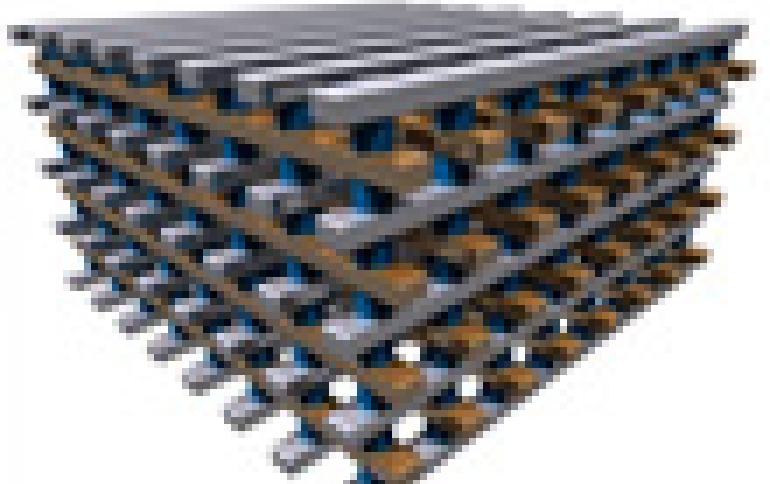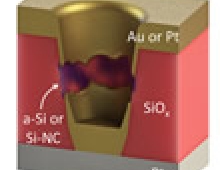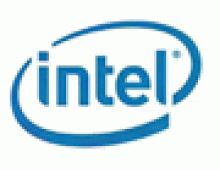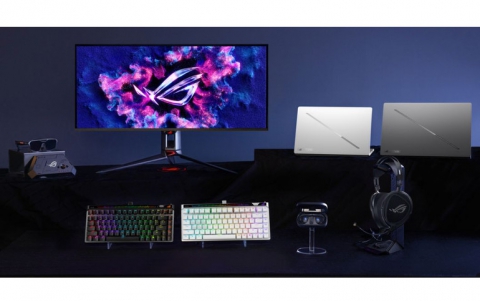
Crossbar Unveils PRAM Non-Volatile Memory Technology
Startup Crossbar emerged from stealth mode Monday to announce its version of RRAM (resistive random-access memory), a new type of memory that could be a successor to flash storage and DRAM.
This new generation of non-volatile memory will be capable of storing up to one terabyte (TB) of data on a single 200mm2 chip, enabling massive amounts of information to be stored and played back from an IC smaller than a postage stamp. Crossbar today also announced it has developed a working Crossbar memory array at a commercial fab, a milestone in the development of new memory technology, signaling its readiness to begin the first phase of productization.
Due to its simple three-layer structure, Crossbar technology can be stacked in 3D, delivering multiple terabytes of storage on a single chip. The company claims that Crossbar's simplicity, stackability and CMOS compatibility enable logic and memory to be easily integrated onto a single chip at the latest technology node, a capability not possible with other traditional or alternative non-volatile memory technologies.
"Non-volatile memory is ubiquitous today, as the storage technology at the heart of the over a trillion dollar electronics market - from tablets and USB sticks to enterprise storage systems," said George Minassian, chief executive officer, Crossbar, Inc. "And yet today?s non-volatile memory technologies are running out of steam, hitting significant barriers as they scale to smaller manufacturing processes. With our working Crossbar array, we have achieved all the major technical milestones that prove our RRAM technology is easy to manufacture and ready for commercialization. It's a watershed moment for the non-volatile memory industry."
Crossbar's technology promises to deliver 20x faster write performance, 20x lower power consumption, and 10x the endurance at half the die size, compared to today's best-in-class NAND Flash memory.
Non-volatile memory is the most common storage technology used for both code storage (NOR) and data storage (NAND) in a wide range of electronics applications. According to market research firm Webfeet Research, non-volatile memory is expected to grow to become a $48.4 billion market in 2016. Crossbar plans to bring to market standalone chip solutions, optimized for both code and data storage, used in place of traditional NOR and NAND Flash memory. Crossbar also plans to license its technology to system on a chip (SOC) developers for integration into next-generation SOCs.
Due to its simple three-layer structure, Crossbar technology can be stacked in 3D, delivering multiple terabytes of storage on a single chip. The company claims that Crossbar's simplicity, stackability and CMOS compatibility enable logic and memory to be easily integrated onto a single chip at the latest technology node, a capability not possible with other traditional or alternative non-volatile memory technologies.
"Non-volatile memory is ubiquitous today, as the storage technology at the heart of the over a trillion dollar electronics market - from tablets and USB sticks to enterprise storage systems," said George Minassian, chief executive officer, Crossbar, Inc. "And yet today?s non-volatile memory technologies are running out of steam, hitting significant barriers as they scale to smaller manufacturing processes. With our working Crossbar array, we have achieved all the major technical milestones that prove our RRAM technology is easy to manufacture and ready for commercialization. It's a watershed moment for the non-volatile memory industry."
Crossbar's technology promises to deliver 20x faster write performance, 20x lower power consumption, and 10x the endurance at half the die size, compared to today's best-in-class NAND Flash memory.
Non-volatile memory is the most common storage technology used for both code storage (NOR) and data storage (NAND) in a wide range of electronics applications. According to market research firm Webfeet Research, non-volatile memory is expected to grow to become a $48.4 billion market in 2016. Crossbar plans to bring to market standalone chip solutions, optimized for both code and data storage, used in place of traditional NOR and NAND Flash memory. Crossbar also plans to license its technology to system on a chip (SOC) developers for integration into next-generation SOCs.





















